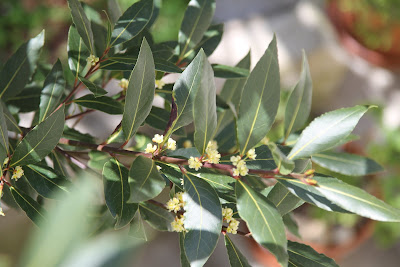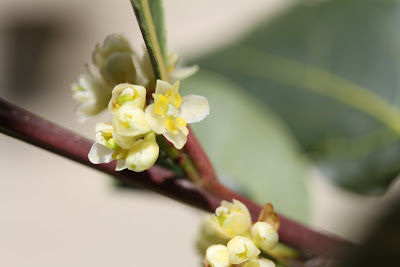
We’ve often wondered what the sex of our Bay Laurel (Laurus nobilis) is. We dug around and found, we think, an answer in the book Class Book of Botany, Part 1 by John Hutton Balfour (MDCCCLII – 1852)[ref]. From this book:
Page 217. Figure 583
Staminiferous flower of Laurel (Laurus nobilis). The perianth is in four divisions, the stamens in twelve, in three rows, some of them introse, others extrorse, opening by hinged valves, as shown in stamen, s. Near the base of the stamens peculiar double glands are seen.
Page 217. Figure 584
Pistilliferous flower of Laurel (Laurus nobilis). The perianth has four divisions, there is a single pistil, and two abortive or rudimentary stamens.
A little terminology recap:
Page 217. Figure 583
Staminiferous flower of Laurel (Laurus nobilis). The perianth is in four divisions, the stamens in twelve, in three rows, some of them introse, others extrorse, opening by hinged valves, as shown in stamen, s. Near the base of the stamens peculiar double glands are seen.
Page 217. Figure 584
Pistilliferous flower of Laurel (Laurus nobilis). The perianth has four divisions, there is a single pistil, and two abortive or rudimentary stamens.
A little terminology recap:
- Stamens are the male, pollen-producing reproductive organ of a flower.
- Staminiferous flower is a flower with only stamens and no pistils?
- Pistils are the female, ovule-bearing organ of a flower.
- Pistilliferous flower is a flower with only pistils and no stamens?
- Perianth is the outer envelope of a flower that consists of either the calyx or the corolla, or both.
- Anther is the pollen-bearing part of the stamen.
- Introse describes the condition when the faces of the anthers are toward the center of the flower.
- Extrose describes the condition when the faces of the anthers are towards the periphery of the flower.
So based on the help from the Class Book of Botany, some close up photos (shown below), and a jeweler’s loupe (to look at the flower parts up close) we think we have a female plant because our nobilis flower simply doesn’t have enough stamens to be male (according to the description above), except for two rudimentary ones.
Update: April 2013
It’s a female. Just a week ago during some pruning, we found a berry!


Flowering Branches



Flower Closeup

It would be helpful if you labeled the floral structure in the diagram.
ReplyDeleteVery helpful since resources on distinguishing the sexes is graphically scant.
ReplyDelete